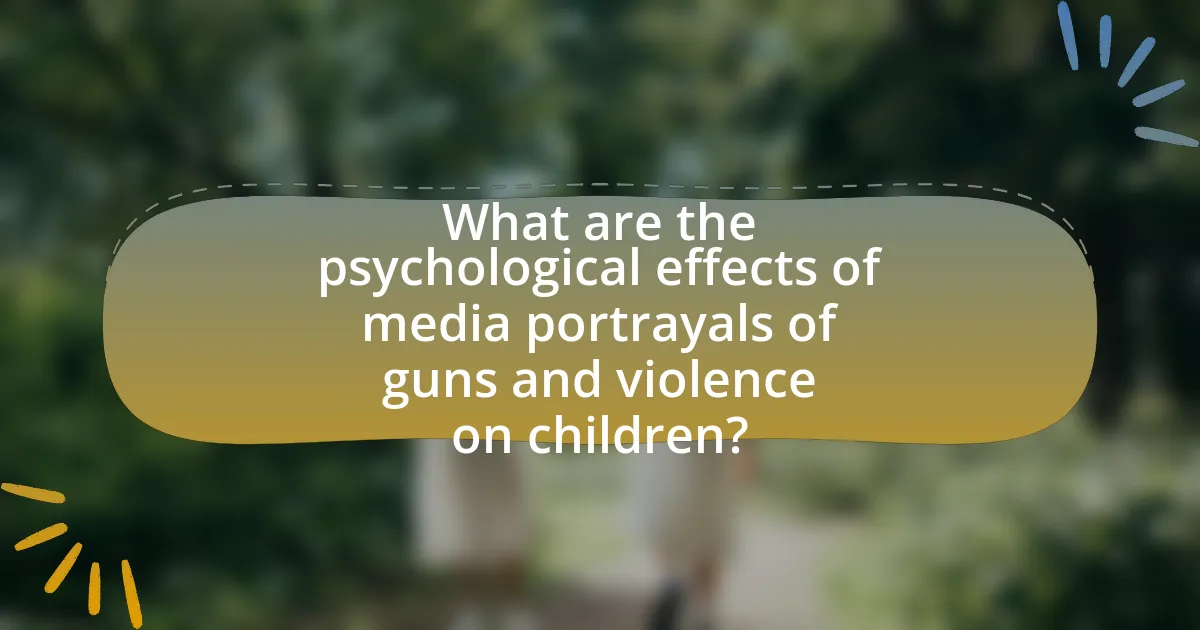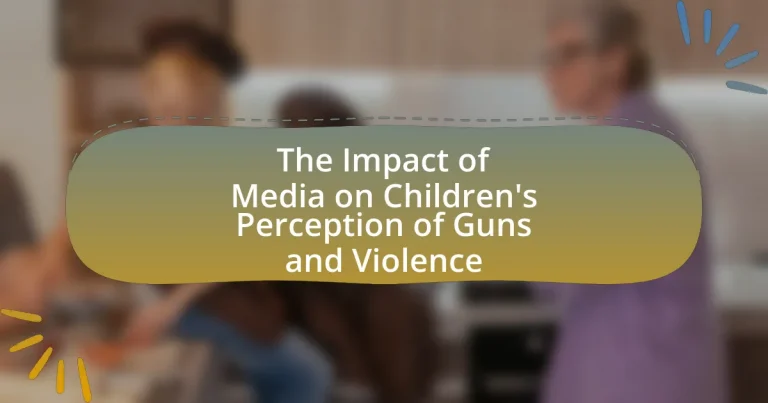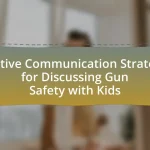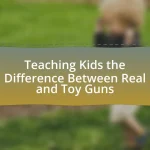The article examines the impact of media on children’s perceptions of guns and violence, highlighting how exposure to violent content normalizes aggressive behavior and desensitizes children to real-life consequences. Research indicates that frequent consumption of violent media, including television, video games, and social media, correlates with increased aggression and distorted views of conflict resolution. The article discusses the psychological effects of media portrayals, the role of parental guidance, and the societal implications of children’s perceptions shaped by media. It emphasizes the importance of media literacy and community programs in fostering healthier attitudes towards violence and conflict resolution among children.
What is the Impact of Media on Children’s Perception of Guns and Violence?
Media significantly shapes children’s perception of guns and violence by normalizing aggressive behavior and desensitizing them to real-life consequences. Research indicates that exposure to violent media content, such as video games and movies, correlates with increased aggression and fearfulness in children. For instance, a study published in the journal “Pediatrics” found that children who frequently consume violent media are more likely to exhibit aggressive thoughts and behaviors. Additionally, the American Psychological Association has reported that children exposed to media violence may develop a distorted view of reality, believing that violence is a common and acceptable way to resolve conflicts. This influence can lead to a greater acceptance of guns as tools for problem-solving, further impacting their attitudes toward violence in society.
How does media exposure shape children’s views on guns and violence?
Media exposure significantly shapes children’s views on guns and violence by normalizing aggressive behavior and desensitizing them to real-life consequences. Research indicates that children who frequently consume violent media content are more likely to perceive violence as an acceptable means of resolving conflicts. A study published in the journal “Pediatrics” found that children exposed to violent video games exhibited increased aggression and a diminished emotional response to violence. Furthermore, the American Psychological Association has reported that media portrayals of guns often glamorize their use, leading children to view firearms as symbols of power rather than tools of danger. This combination of normalization and desensitization can influence children’s attitudes towards violence and their understanding of its implications in society.
What types of media are most influential in shaping these perceptions?
The types of media most influential in shaping children’s perceptions of guns and violence include television, video games, and social media. Research indicates that children are exposed to violent content through these platforms, which can normalize aggressive behavior and desensitize them to violence. For instance, a study published in the journal “Pediatrics” found that children who frequently watch violent television shows are more likely to exhibit aggressive behavior and fearfulness. Additionally, video games that feature gun violence have been linked to increased aggression in children, as highlighted by the American Psychological Association. Social media also plays a significant role, as it can amplify exposure to violent imagery and discussions, further influencing children’s perceptions.
How do different genres of media portray guns and violence?
Different genres of media portray guns and violence in varied ways, influencing audience perceptions significantly. Action films often glamorize gun use, depicting it as heroic and thrilling, which can lead to desensitization towards real-life violence. In contrast, news media typically presents gun violence in a more serious context, focusing on its consequences and societal impact, which can evoke fear and concern among viewers. Video games frequently incorporate guns as central gameplay mechanics, often normalizing their use in a virtual environment, which research has shown can affect children’s attitudes towards aggression and conflict resolution. Studies, such as those by Anderson and Dill (2000), indicate that exposure to violent video games correlates with increased aggression in children. Thus, the portrayal of guns and violence across different media genres shapes children’s understanding and attitudes towards these issues.
Why is understanding this impact important for society?
Understanding the impact of media on children’s perception of guns and violence is crucial for society because it shapes children’s attitudes and behaviors towards violence. Research indicates that exposure to violent media content can lead to desensitization, increased aggression, and a distorted view of reality among children. For instance, a study published in the journal “Pediatrics” found that children who frequently consume violent media are more likely to exhibit aggressive behavior and fearfulness. This understanding is vital for developing effective educational programs and policies aimed at mitigating the negative effects of media violence, ultimately fostering a safer environment for children and society as a whole.
What are the potential consequences of distorted perceptions?
Distorted perceptions can lead to significant consequences, including increased fear, misinterpretation of reality, and heightened aggression. For instance, children exposed to media portrayals of guns and violence may develop an exaggerated sense of danger, believing that violent encounters are more common than they are. Research indicates that children who frequently consume violent media are more likely to exhibit aggressive behavior and desensitization to violence, as shown in studies published in the Journal of Communication, which found a correlation between media violence exposure and increased aggression in youth. Additionally, distorted perceptions can impair children’s ability to distinguish between fantasy and reality, leading to anxiety and behavioral issues.
How can awareness of media influence lead to better outcomes for children?
Awareness of media influence can lead to better outcomes for children by enabling them to critically evaluate the content they consume, particularly regarding themes of guns and violence. When children understand how media shapes perceptions, they are less likely to internalize harmful stereotypes or normalize violent behavior. Research indicates that children exposed to media literacy programs demonstrate improved critical thinking skills and a greater ability to discern between reality and fiction, which can reduce aggressive tendencies. For instance, a study published in the Journal of Communication found that media literacy education significantly decreased the likelihood of children adopting violent behaviors after exposure to violent media content. This evidence supports the notion that fostering awareness of media influence equips children with the tools to navigate media messages more effectively, ultimately leading to healthier attitudes and behaviors.

What are the psychological effects of media portrayals of guns and violence on children?
Media portrayals of guns and violence significantly impact children’s psychological development, often leading to increased aggression, desensitization to violence, and fear. Research indicates that children exposed to violent media content may exhibit heightened aggressive thoughts and behaviors, as evidenced by a meta-analysis conducted by Anderson et al. (2010) in the journal “Psychological Bulletin,” which found a consistent correlation between violent media exposure and increased aggression in children. Furthermore, repeated exposure to gun violence in media can normalize such behavior, making children less sensitive to real-life violence and more likely to accept it as a part of everyday life. This desensitization can lead to diminished empathy and an increased likelihood of engaging in violent behavior themselves. Additionally, children may develop anxiety and fear related to their safety, as they internalize the violent scenarios depicted in media.
How do children process violent media content?
Children process violent media content by interpreting it through their cognitive and emotional development stages. Research indicates that younger children may struggle to distinguish between fantasy and reality, leading to confusion and fear, while older children can analyze and contextualize the violence but may still be influenced by it. A study by Anderson and Dill (2000) found that exposure to violent video games can increase aggressive thoughts and behaviors in children, demonstrating that repeated exposure can shape their perceptions of violence as acceptable or normal. This processing is influenced by factors such as age, parental guidance, and individual temperament, which can either mitigate or exacerbate the effects of violent media.
What age-related factors influence children’s interpretation of violence?
Children’s interpretation of violence is influenced by their developmental stage, cognitive abilities, and social experiences. Younger children, typically under the age of 7, often struggle to differentiate between fantasy and reality, leading them to interpret violent media as real-life scenarios. As children grow older, particularly around ages 8 to 12, they begin to develop critical thinking skills, allowing them to analyze and question the motives behind violent actions in media. Adolescents, aged 13 and above, are more capable of understanding complex social dynamics and moral implications, which can shape their perceptions of violence in a more nuanced way. Research indicates that exposure to violent media can lead to desensitization and normalization of aggressive behavior, particularly in younger audiences who are still forming their understanding of social norms and consequences.
How does repeated exposure to violent media affect children’s behavior?
Repeated exposure to violent media negatively affects children’s behavior by increasing aggression and desensitization to violence. Research indicates that children who frequently consume violent content are more likely to exhibit aggressive thoughts, feelings, and behaviors. A meta-analysis by Anderson and Dill (2000) found that exposure to violent video games significantly correlates with increased aggression in children. Additionally, a study published in the Journal of Pediatrics (2013) demonstrated that children exposed to violent media are less sensitive to the suffering of others, indicating desensitization. These findings underscore the detrimental impact of violent media on children’s behavioral development.
What role does parental guidance play in mediating media effects?
Parental guidance plays a crucial role in mediating media effects by influencing children’s interpretation and response to media content. Research indicates that active parental involvement, such as discussing media messages and setting viewing limits, can significantly reduce the likelihood of children adopting aggressive behaviors or desensitization to violence. For instance, a study published in the journal “Pediatrics” found that children who engaged in discussions about violent media with their parents were less likely to exhibit aggressive tendencies compared to those who consumed media without parental interaction. This demonstrates that parental guidance not only shapes children’s understanding of media but also serves as a protective factor against negative media influences.
How can parents effectively discuss media content with their children?
Parents can effectively discuss media content with their children by engaging in open conversations that encourage critical thinking about the messages portrayed in media. This approach allows children to analyze and question the content they consume, fostering a deeper understanding of its impact, particularly regarding themes of guns and violence. Research indicates that children who engage in discussions about media with their parents are better equipped to differentiate between reality and fiction, which is crucial in understanding the portrayal of violence in media. For instance, a study published in the Journal of Communication found that parental mediation significantly influences children’s perceptions of media violence, leading to more informed and critical viewers.
What strategies can parents use to limit exposure to violent media?
Parents can limit exposure to violent media by implementing strict media guidelines and actively engaging in their children’s media consumption. Establishing rules about the types of content that can be viewed, such as restricting access to violent video games and movies, is essential. Additionally, parents can utilize parental controls on devices and streaming services to filter out inappropriate content. Research indicates that children who are exposed to violent media are more likely to exhibit aggressive behavior, highlighting the importance of these strategies in promoting healthier media habits. Engaging in discussions about media content with children can also help them critically analyze what they watch, fostering a better understanding of violence and its consequences.
What are the societal implications of children’s perceptions of guns and violence influenced by media?
Children’s perceptions of guns and violence, influenced by media, lead to significant societal implications, including desensitization to violence and normalization of aggressive behavior. Research indicates that exposure to violent media content can increase the likelihood of children exhibiting aggressive thoughts and behaviors, as evidenced by a meta-analysis conducted by Anderson et al. (2010) in the journal “Psychological Bulletin,” which found a consistent correlation between violent media exposure and increased aggression in children. This normalization can contribute to a culture where violence is seen as an acceptable means of conflict resolution, potentially increasing real-world violence and impacting community safety. Furthermore, children’s perceptions shaped by media can influence their attitudes towards firearms, leading to increased acceptance of gun use and a higher likelihood of risky behaviors associated with firearms.
How do these perceptions affect children’s interactions with peers?
Children’s perceptions of guns and violence, shaped by media exposure, significantly influence their interactions with peers. These perceptions can lead to increased aggression, desensitization to violence, and a normalization of gun use in social settings. Research indicates that children who frequently consume violent media are more likely to exhibit hostile behaviors and engage in conflicts with peers, as evidenced by a study published in the Journal of Abnormal Child Psychology, which found a correlation between violent media consumption and aggressive behavior in children. Additionally, children may mimic violent scenarios they observe, impacting their play and social dynamics, often resulting in exclusion or bullying among peers who do not share similar views on violence.
What impact does media-influenced perception have on bullying and aggression?
Media-influenced perception significantly contributes to the normalization and escalation of bullying and aggression among children. Research indicates that exposure to violent media content can desensitize children to aggression, making them more likely to engage in or tolerate bullying behaviors. For instance, a study published in the Journal of Adolescent Health found that children who frequently consume violent media are more prone to exhibit aggressive behavior and have a higher likelihood of being involved in bullying, either as perpetrators or victims. This correlation suggests that media portrayals of violence can shape children’s understanding of social interactions, leading them to perceive aggression as an acceptable means of conflict resolution.
How can media shape children’s understanding of conflict resolution?
Media can shape children’s understanding of conflict resolution by providing narratives that illustrate various approaches to resolving disputes. For instance, children’s programming often depicts characters engaging in dialogue, negotiation, or compromise to solve conflicts, which can influence young viewers to adopt similar strategies in real-life situations. Research indicates that exposure to positive conflict resolution models in media can enhance children’s social skills and empathy, as demonstrated in a study published in the Journal of Communication, which found that children who watched shows emphasizing cooperative problem-solving were more likely to exhibit prosocial behaviors. Thus, media serves as a powerful tool in shaping children’s perceptions and approaches to resolving conflicts.
What measures can be taken to mitigate negative media influences?
To mitigate negative media influences, parents and educators should actively engage in media literacy education. This approach equips children with critical thinking skills to analyze and question media content, reducing susceptibility to harmful messages about guns and violence. Research indicates that children who participate in media literacy programs demonstrate improved understanding of media’s impact on perceptions and behaviors, as shown in a study by the Center for Media Literacy, which highlights the effectiveness of such programs in fostering critical engagement with media. Additionally, setting limits on screen time and monitoring content can further shield children from exposure to violent media, reinforcing the importance of positive media consumption.
What role do educators play in addressing media influence on children?
Educators play a crucial role in addressing media influence on children by facilitating critical thinking and media literacy skills. They guide students in analyzing and questioning the content they consume, particularly regarding portrayals of guns and violence in media. Research indicates that children exposed to violent media are more likely to exhibit aggressive behavior; therefore, educators can implement programs that teach students to discern between reality and fiction, fostering a more informed perspective. For instance, studies show that media literacy education can reduce the likelihood of children adopting violent behaviors by helping them understand the implications of media messages.
How can community programs promote healthy perceptions of violence and conflict?
Community programs can promote healthy perceptions of violence and conflict by providing education and fostering dialogue among participants. These programs often include workshops, conflict resolution training, and peer mediation initiatives that teach individuals to understand and manage conflicts constructively. For instance, research shows that programs like the PeaceBuilders initiative have successfully reduced aggressive behavior in children by teaching them social-emotional skills and conflict resolution strategies. By engaging community members in discussions about the consequences of violence and the importance of peaceful conflict resolution, these programs help reshape attitudes and beliefs surrounding violence, leading to a more peaceful community environment.
What practical steps can parents take to foster healthy media consumption?
Parents can foster healthy media consumption by establishing clear guidelines for media use, including setting time limits and monitoring content. Research indicates that children who have structured media environments are less likely to engage in risky behaviors and develop healthier viewing habits. For instance, the American Academy of Pediatrics recommends that parents co-view media with their children to facilitate discussions about content, which can help children critically analyze media messages, particularly regarding violence and guns. Additionally, parents should encourage alternative activities, such as outdoor play and reading, to balance screen time and promote overall well-being.


